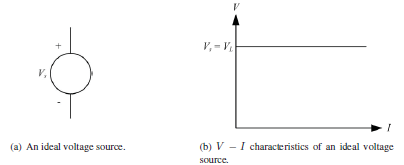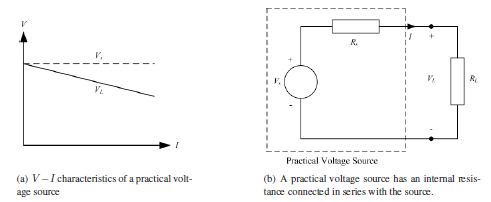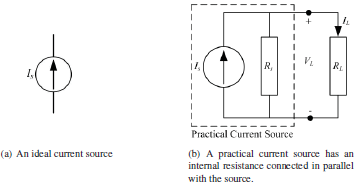Voltage And Current Sources
DC Sources: In general, there are two main types of DC sources
- Independent (Voltage and Current) Sources
- Dependent (Voltage and Current) Sources
An independent source produces its own voltage and current through some chemical reaction and does not depend on any other voltage or current variable in the circuit. The output of a dependent source, on the other hand, is subject to a certain parameter (voltage or current) change in a circuit element. Herein, the discussion shall be confined to independent sources only.
DC Voltage Source: This can be further subcategorised into ideal and non-ideal sources.
The Ideal Voltage Source An ideal voltage source, shown in Figure (a), has a terminal voltage which is independent of the variations in load. In other words, for an ideal voltage source, the supply current alters with changes in load but the terminal voltage, VL always remains constant. This characteristic is depicted in given figure(b).

Non-Ideal or Practical Voltage Source For a practical source, the terminal voltage falls off with an increase in load current. This can be shown graphically in Figure(a). This behaviour can be modelled by assigning an internal resistance, Rs, in series with the source as shown in Figure(b).

Characteristics and model of a practical voltage source
where RL represents the load resistance. The characteristic equation of the practical voltage source can be written as
VL = Vs − RsI
For an ideal source, Rs = 0 and therefore VL = Vs.
DC Current Source: A current source, unlike the DC voltage source, is not a physical reality. However, it is useful in deriving equivalent circuit models of semiconductor devices such as a transistor. It can also be subdivided into ideal and non-ideal categories.
The Ideal Current Source By definition, an ideal current source, depicted in Figure(a), produces a current which is independent of the variations in load. In other words the current supplied by an ideal current source does not change with the load voltage.
Non-Ideal or Practical Current Source The current delivered by a practical current source falls off with an increase in load or load voltage. This behaviour can be modelled by connecting a resistance in parallel with the ideal current source as shown in Figure(b) where Rs is the internal

resistance of the current source and RL represents the load.
The characteristic equation of the practical current source can be written as
IL = Is − VL
Rs
In an ideal current source, Rs = ∞(open circuit), therefore IL = Is.